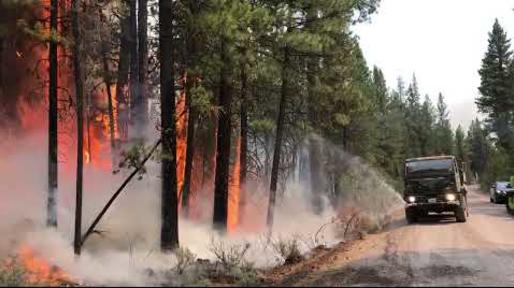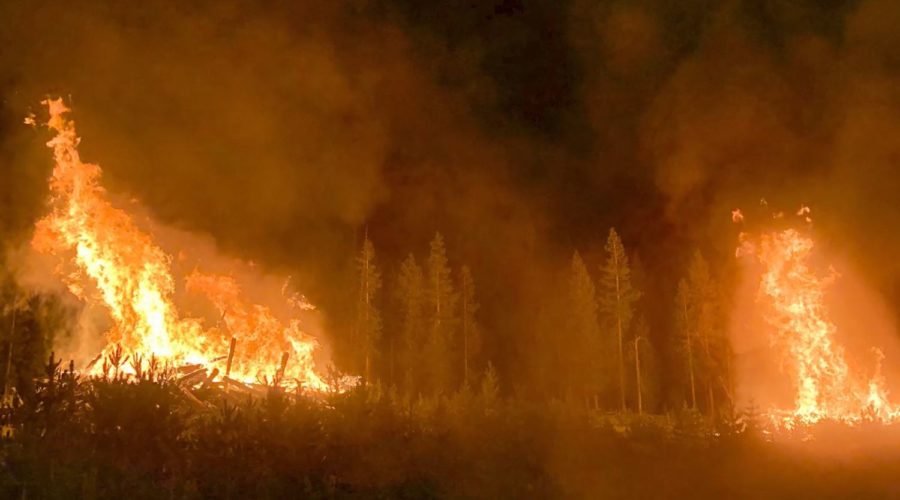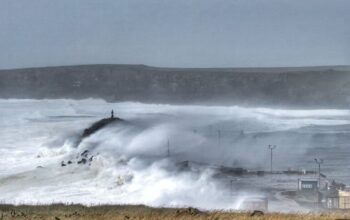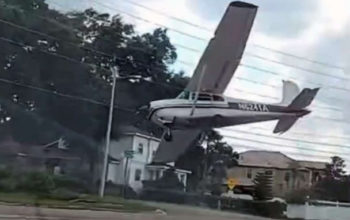In the state of Oregon, the nation’s largest active wildfire has burned through more than 364,000 acres, prompting thousands of evacuations.
Over 2,000 firefighters are tackling the so-called Bootleg Fire – one of the largest blazes in Oregon’s history.

Since starting on 6 July, it has already scorched an area larger than the city of Los Angeles.
It is one of more than 80 major fires raging across 13 US states, spurred by heatwaves and high winds.
Climate change increases the risk of the hot, dry weather that is likely to fuel wildfires.
The world has already warmed by about 1.2C since the industrial era began and temperatures will keep rising unless governments around the world make steep cuts to emissions.
The Bootleg Fire in Oregon, named after the nearby Bootleg Spring, has forced at least 2,000 residents from mostly rural areas to abandon their homes. At least 160 homes and buildings have been destroyed so far. No deaths have yet been reported.
Authorities said that about one-third of the fire’s perimeter had been contained.
“We’ve had to fight for pretty much every foot of this, but we’re getting there,” said John Flannigan, an operations section chief at a news conference on Monday.
Mr Flannigan described the intensity of the fire as that of a hurricane, saying that it had ripped trees out of the ground.
The blaze has grown so large that it is effectively creating its own weather. Intense wildfires, like Bootleg, move with such energy that they can create pyrocumulus clouds – also known as “fire clouds”. These clouds are so hot and big they can create their own weather systems, like hurricane and lightning.
One resident near the town of Bly whose home was destroyed by the Bootleg Fire, Sayyid Bey, said he watched from afar as the blaze burned through the trees towards his property. “It was red, like we were on Mars,” he said.
The fire, which is burning 300 miles (480km) south-east of Portland, threatens to destroy thousands more properties as it continues to spread.
Two evacuation centers have been set up for residents in several cities, including Klamath Falls and Redmond.
On Sunday, Mr Flannigan told US media the hot and dry weather created “unstable” air which raises the heat faster.
Temperatures are expected to be between 10 and 15 degrees Fahrenheit above normal and the region is also experiencing a drought, which could worsen in the days ahead.
Wildfires have already torn through more than 1.2m acres of the country this year, mainly in western states, according to the National Interagency Fire Center.
More than 4,000 blazes have been recorded by the organisation so far in 2021, which is almost double last year’s total.
In California alone, five times as many acres have burned compared with the same period last year.
One of the state’s recent fires, called the Dixie Fire, has been linked to PG&E – a utility firm whose power lines were blamed for starting the 2018 Camp Fire, the deadliest in California’s history.
The spate of fires marks a heavier-than-normal start to the wildfire season in the western US, and has coincided with record-breaking heat waves in recent weeks.
Meanwhile in neighbouring Canada, more than 150 new fires started burning in this past weekend alone, according to the Canadian Interagency Forest Fire Centre. More than 4,300 blazes have been recorded by the non-profit in 2021 so far.
In the province of British Columbia alone, crews are battling hundreds of fires, straining available accommodation for those who have been forced to flee.
Smoke from the western province has spread nearly 2,000 kilometres, forcing health authorities to issue warnings to millions of people around the country.
The elderly, children and those with cardiovascular issues are advised to limit outdoor activities and drink extra water until the smoke passes. Read more from BBC





